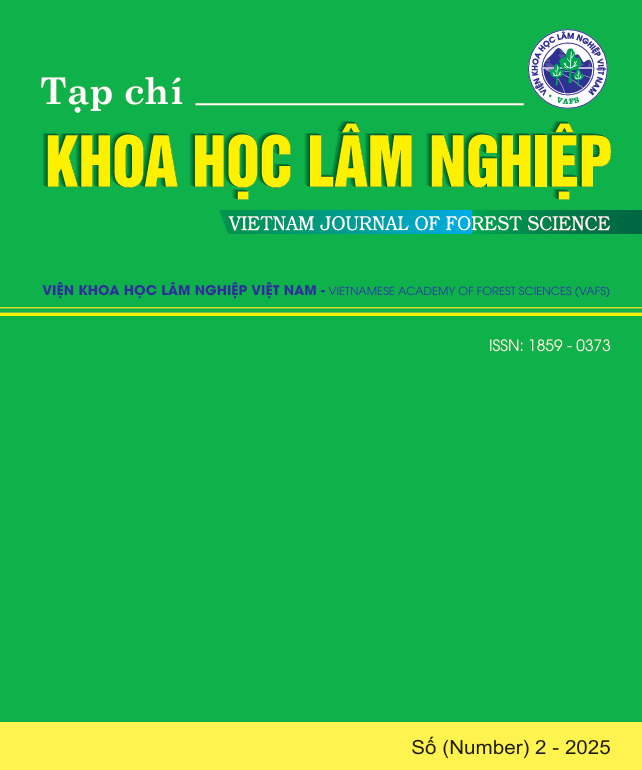SEVERAL STRUCTURAL CHARACTERISTICS OF FORESTS AND NATURAL FOREST REGENERATION OF Sindora tonkinensis A. Chev. ex K. & S. S. Larsen IN QUANG TRI PROVINCE
DOI:
https://doi.org/10.70169/VJFS.1036Keywords:
Sindora tonkinensis, forest structure, natural regeneration, Quang Tri provinceAbstract
Sindora tonkinensis is a rare native species listed in Vietnam's Red Book, known for its economic value. However, due to over-exploitation in recent years, the distribution of this species in natural forests has significantly declined.The study on the forest structure and natural regeneration of Sindora tonkinensis in several natural broadleaf evergreen and semi-deciduous forest types in Quang Tri province reveals that the density of the tree layer varies between 496 trees/ha and 692 trees/ha, with the number of species ranging from 36 species to 52 species. The density of Sindora tonkinensis trees fluctuates from 8 to 16 trees/ha, accounting for 1.34% to 2.72% of the total tree population, with a standing volume ranging from 1.80 m³/ha to 13.92 m³/ha. In the natural forest states, Sindora tonkinensis does not play a significant role in the forest composition, and its IV index is very low, ranging from 1.8% to 3.2%. The density of regenerated trees shows considerable variation, ranging from 6,640 trees/ha to 10,240 trees/ha, with regeneration quality predominantly ranging from good to medium. Seed-origin regeneration accounts for a substantial proportion, varying from 85.8% to 95.4%. The regeneration density of Sindora tonkinensis is very low, ranging from 80 trees/ha to 320 trees/ha, with good to medium quality, and all regeneration is seed-origin. The number of regenerating tree species in the sample plots ranges from 17 to 29 species, with 5 to 9 species significantly contributing to the forest composition. Regenerating Sindora tonkinensis does not play a dominant role in the forest structure, with its Ki% index ranging from 1.1% to 3.0% in plots where Sindora tonkinensis is present. The number of regenerated trees decreases with increasing height class, but the regenerated trees are expected to provide a sufficient quantity for forest recovery.
References
1. Vũ Đức Bình, Nguyễn Hải Thành, Hoàng Văn Tuấn, Lê Công Định, Nguyễn Thi Thanh Nga, Nguyễn Du, Nguyễn Văn Lợi, Trương Minh Quảng, 2025. Nghiên cứu đặc điểm phân bố, sinh thái và tái sinh của Gụ lau (Sindora tonkinensis A. Chev. Ex K. & S. S. Larsen) tại Khu Dự trữ Thiên nhiên Động Châu - Khe Nước Trong tỉnh Quảng Bình. Tạp chí Khoa học Lâm nghiệp số 1/2025, 36-49.
2. Bộ Khoa học và Công nghệ, 2007. Sách Đỏ Việt Nam - Phần II. Thực vật. Nhà xuất bản Khoa học và Kỹ thuật.
3. Bộ Nông nghiệp và Phát triển nông thôn, 2023. Thông tư số 16/2023/TT-BNNPTNT về việc sửa đổi, bổ sung một số điều của thông tư số 33/2018/TT-BNNPTNT ngày 16 tháng 11 năm 2018 của Bộ trưởng Bộ Nông nghiệp và Phát triển nông thôn quy định về điều tra, kiểm kê và theo dõi diễn biến rừng.
4. Bộ Nông nghiệp và Phát triển nông thôn, 2024. Quyết định số 816/QĐ-BNN-KL ngày 20/03/2025 về việc công bố hiện trạng rừng toàn quốc năm 2023.
5. Brooks C.N.P and Carruther, N, 1953. Handbook of statistical methods in Meteorology. Her Majesty's Stationary Office, London.
6. Lê Mộng Chân và Lê Thị Huyên, 2000. Thực vật rừng, Nhà xuất bản Nông nghiệp, Hà Nội.
7. Daniel Marmillod, 1982. Methodology and results of studies on the composition and structure of a terrace forest in Amazonia. Doctorate. Georg - August - Universität Göttingen., Göttingen.
8. Trần Minh Đức, Lê Thị Diên, Võ Thị Minh Phương, Trần Nam Thắng, Nguyễn Thị Thương, Lê Thái Hùng, 2015. Kỹ thuật gây trồng một số loài cây thân gỗ. Nhà xuất bản Nông nghiệp, Hà Nội.
9. Trần Hợp, 2002. Tài nguyên cây gỗ Việt Nam, Nxb Nông Nghiệp, Hà Nội.
10. Vũ Đình Huề, 1984. Chỉ số IV% được xác định theo phương pháp của Daniel Marmillod.
11. Nguyễn Văn Huy, Vũ Ngọc Huy, Phạm Quốc Tuấn, Trương Lê Hiếu, 2007. Một số loài cây phân bố trong rừng tự nhiên Khu vực Lâm trường Trường Sơn - Long Đại tỉnh Quảng Bình - Việt Nam.
12. Nguyễn Tử Kim, Nguyễn Đình Hưng, Đỗ Văn Bản, Nguyễn Tử Ưởng, 2015. Át-lát cấu tạo, tính chất gỗ và tre Việt Nam (tập II). Viện Khoa học Lâm nghiệp Việt Nam. Nhà xuất bản Nông Nghiệp, Hà Nội.
13. Sørensen T. A, 1948. A method of establishing groups of equal amplitude in plant sociology based on similarity of species content, and its application to analyses of the vegetation on Danish commons, Kgl Danske Vidensk, Selsk. Biol. Skr. 5 (1948) 1-34.
14. Thái Văn Trừng, 1978. Thảm thực vật rừng Việt Nam. Nhà xuất bản khoa học và kỹ thuật Hà Nội
15. Nguyễn Hải Tuất, Ngô Kim Khôi, 1996. Xử lý thống kê và kết quả nghiên cứu thực nghiệm trong Nông lâm nghiệp trên máy tính. Nhà xuất bản Nông nghiệp, Hà Nội.









